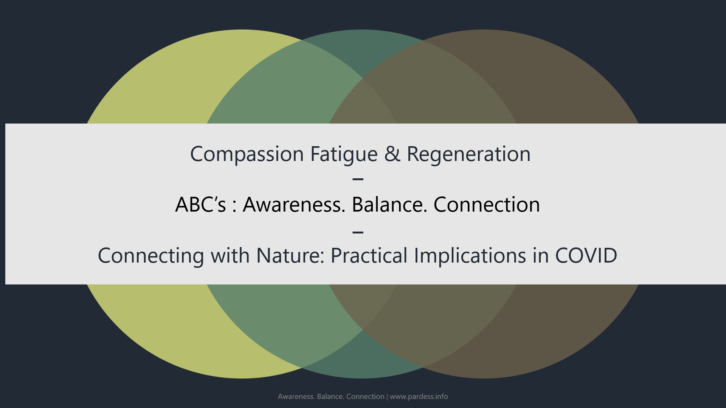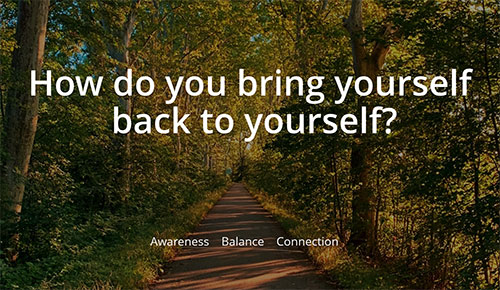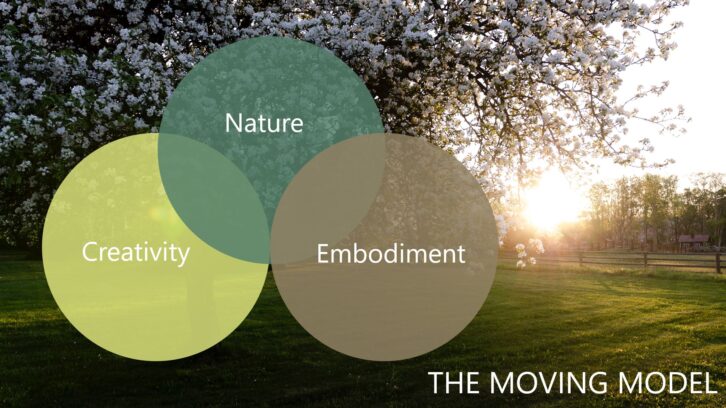Caregivers, individuals who provide ongoing physical, emotional, or psychological care to others, often experience significant stress and burnout. The MOVING model, a nature-based intervention, offers a novel approach to addressing the unique challenges faced by caregivers. By incorporating outdoor activities, mindfulness practices, and expressive arts, MOVING seeks to re-establish a sense of balance and vitality for caregivers. This paper will delve into the theoretical underpinnings of the MOVING model, its practical implementation, and its potential impact on caregiver well-being.


The Concept of MOVING
The MOVING model is grounded in the belief that connection with nature can foster personal growth, resilience, and healing. The acronym MOVING encapsulates the core components of the program: Mindfulness, Openness, Vulnerability, Inclusion, Nurturance, and Group Connectedness.
Mindfulness: Cultivating present-moment awareness is essential for reducing stress and promoting emotional regulation. Nature-based activities provide a conducive environment for mindfulness practices, such as meditation and mindful walking.
Openness: Embracing new experiences and perspectives is crucial for personal growth. Nature offers endless opportunities for exploration and discovery, fostering a sense of wonder and curiosity.
Vulnerability: Sharing emotions and experiences in a supportive environment is essential for healing and building resilience. Nature can provide a safe and inspiring setting for self-expression and connection with others.
Inclusion: Creating a sense of belonging and acceptance is vital for caregiver well-being. The MOVING model emphasizes diversity and inclusivity, fostering a supportive community among participants.
Nurturance: Self-care is essential for caregivers to maintain their own well-being. Nature-based activities can provide opportunities for relaxation, rejuvenation, and self-compassion.
Group Connectedness: Building strong relationships with peers can provide emotional support and a sense of community. The MOVING model emphasizes group activities and shared experiences to foster connection among caregivers.

Nature, Creativity and Embodiment: The MOVING Model in Practice
The MOVING model involves a series of nature-based workshops conducted within the framework of two or three-day retreats. These retreats combine outdoor physical activities, such as hiking and nature exploration, with expressive arts and mindfulness practices. Participants are encouraged to explore metaphors from nature, such as the resilience of a burnt tree or the grounding power of roots, to deepen their understanding of their own experiences.
The model also emphasizes the importance of physical movement. Engaging in activities like stretching, breathing exercises, dance therapy, or martial arts can help release physical tension and promote emotional well-being. Additionally, the concept of "shared emotional voyage" encourages participants to share their experiences and emotions in a supportive environment.

The concept of M.O.V.I.N.G Encounters highlights the idea Of creating the conditions that may facilitate moving in relationship to oneself, others, and the world.
The choice of the term MOVING captures multiple meanings, including:
1. The actual physical movement which is an important part of the seminar program incorporating the nature excursions, stretching and breathing exercises as well as relaxation techniques and possibilities of dance therapy or martial art therapies. The MOVING model's emphasis on physical movement, mindfulness, and emotional expression strongly aligns with the core principle of embodiment.
2. Moving in the emotional sense of the "Shared E-motional Voyage": Creating a secure space for sharing emotion.
3. Moving along together includes moving backwards (remembering/re-membering) and forward, thus bridging continuity between past, present and future. This process opens new perspectives through reflection on the past (remembering) and progression toward the future, bridging past, present, and future.
4. The concept of moving is also relevant as a natural antidote to the post-traumaric experience of being immobilized, blocked, frozen and stuck in time. Re-establishing the flow of life
The concept of "moving" within the MOVING model extends beyond physical activity to address the psychological and emotional paralysis often experienced by trauma survivors. Trauma can leave individuals feeling emotionally and physically frozen, unable to progress or connect with the present moment. This state of immobility can significantly hinder recovery and overall well-being.
The body's response to trauma often involves a fight, flight, or freeze response. When the body is unable to physically engage in fight or flight, it may resort to a freeze response, leaving the individual feeling stuck in a moment of terror. This can manifest as physical symptoms such as muscle tension, difficulty sleeping, or hypervigilance, as well as emotional symptoms like numbness, detachment, or avoidance.

By incorporating these elements into a group setting, the MOVING model can foster a sense of community and support among caregivers, which is essential for long-term resilience
COVID-19 as a Transformative Opportunity
References:
Brockhouse, R., Msetfi, R. M., Cohen, K., & Joseph, S. (2011). Vicarious exposure to trauma and growth in therapists: The moderating effects of sense of coherence, organizational support, and empathy. Journal of Traumatic Stress, 24(6), 735-742
Calhoun, L. G., & Tedeschi, R. G. (1998). Beyond recovery from trauma: Implications for clinical practice and research. Journal of Social Issues, 54, 357-371.
Cocker, F., & Joss, N. (2016). Compassion fatigue among healthcare,emergency and community service workers: A systematic review. International Journal of Environmental Research and Public Health, 13, 618–635
Dekel, R., Hantman, S., Ginzburg, K., & Solomon , Z. (2007). The cost of caring? Social workers in hospitals confront ongoing terrorism. British Journal of Social Work, 37, 1247-1261.
Figley, C. (1995). Compassion Fatigue: Coping With Secondary Traumatic Stress Disorder in Those Who Treat the Traumatized. New York: Brunner/Mazel, Inc.
Figley, C. R. (2002). Treating Compassion Fatigue. Psychosocial Stress Book Series. New York: Brunner-Rutledge.
Joseph, S. (2011). What doesn’t kill us. The new psychology of posttraumatic growth. New York, NY: Basic Books. Kjellenberg
Jung, C. G. (1951). Fundamental Questions of Psychotherapy. In H. Read, M. Fordham,G. Adler, & W. McGuire (Eds.), The collected works of C. G. Jung, vol. 16. Princeton Princeton University Press.
Kornfield, J. (2008). The wise heart: A guide to the universal teachings of Buddhist psychology. New York:
Linley, P., & Joseph, S. (2007). Therapy work and therapists’ positive and negative well-being.Journal of Social and Clinical Psychology, 26, 385–40
Pearlman, L. A., & Caringi, J. (2009). Living and working self-reflectively to address vicarious trauma. In C. A. Courtois & J. D. Ford (Eds.), Treating complex traumatic stress disorders: An evidence-based guide (pp. 202-224). New York, NY, US: Guilford Press.
Rice, C. A. (2011). The psychotherapist as "wounded healer": A modern expression of an ancient tradition. In R. H. Klein, H. S. Bernard, & V. L. Schermer (Eds.), On becoming a psychotherapist: The personal and professional journey (pp. 165-189). New York, NY, US: Oxford University Press.
Richardson, M., Richardson, E., Hallam, J., & Ferguson, F. J. (2020). Opening doors to nature: Bringing calm and raising aspirations of vulnerable young people through nature-based intervention. The Humanistic Psychologist, 48(3), 284–297.
Rothschild, B. (2006). Help for the helper: The psychophysiology of compassion fatigue and vicarious trauma. New York: W.W. Norton.
Saakvitne, K.W., Pearlman, L.A., & the Staff of the Traumatic Stress Institute (1996). Transforming the pain: A workbook on vicarious traumatization. New York: W.W. Norton.
Serlin, I., Cannon, J. T. (2004). A humanistic approach to the psychology of trauma. In D. Knafo, (Eds.), Living with terror, working with trauma: A clinician's handbook (pp. 313-330). Lanham, MD: Rowman & Littlefield.
Vachon, M. L. S. (2015). Care of the caregiver: Professionals and family members. In J. M. Stillion & T. Attig (Eds.), Death, dying, and bereavement: Contemporary perspectives, institutions, and practices (pp. 379-393). New York, NY, US: Springer Publishing Co
Compassion fatigue and burnout- COVID related resources:
Ali, D. A., Figley, C. R., Tedeschi, R. G., Galarneau, D., & Amara, S. (2021). Shared Trauma , Resilience , and Growth : A Roadmap Toward Transcultural Conceptualization.
Mendenhall, T. (2021). We Are in This Together : Maintaining Our Health Care Teams ’ Wellness During Challenging Times. 39(3), 541–543.
Smith-macdonald, L., Lusk, J., Lee-baggley, D., Bright, K., Laidlaw, A., Voth, M., Spencer, S., Cruikshank, E., Pike, A., Jones, C., & Bremault-phillips, S. (2022). Companions in the Abyss : A Feasibility and Acceptability Study of an Online Therapy Group for Healthcare Providers Working During the COVID-19 Pandemic. 12(January), 1–13.12(January), 1–13.0
Whitt-woosley, A., Sprang, G., & Eslinger, J. (2022). The Impact of COVID-19 and Experiences of Secondary Traumatic Stress and Burnout. 14(3), 507–515.
Nature as a resource: An extended list of references:
Anderson, C. L., Monroy, M., & Keltner, D. (2018). Awe in nature heals: Evidence from military veterans, at-risk youth, and college students. Emotion, 18(8), 1195–1202
Barnes, M. R., Donahue, M. L., Keeler, B. L., Shorb, C. M., Mohtadi, T. Z., & Shelby, L. J. (2019). Characterizing nature and participant experience in studies of nature exposure for positive mental health: An integrative review. Frontiers in Psychology, 9, Article 261
Berger, R., & Tiry, M. (2012). The enchanting forest and the healing sand—Nature therapy with people coping with psychiatric difficulties. The Arts in Psychotherapy, 39(5), 412–416
Berman, M. G., Jonides, J., & Kaplan, S. (2008). The Cognitive Benefits of Interacting With Nature. 19(12), 1207–1212.
Bratman, G. N., Hamilton, J. P., Hahn, K. S., Daily, G. C., & Gross, J. J. (2015). Nature experience reduces rumination and subgenual prefrontal cortex activation. PNAS Proceedings of the National Academy of Sciences of the United States of America, 112(28), 8567–8572.
Caldwell, C. (2018) . Bodyfulness: Somatic practices for presence, empowerment, and waking up in this life . Shambhala Publications
Corley, J., Okely, J. A., Taylor, A. M., Page, D., Welstead, M., Skarabela, B., Redmond, P., Cox, S. R., & Russ, T. C. (2021). Home garden use during COVID-19: Associations with physical and mental wellbeing in older adults. Journal of Environmental Psychology, 73(August 2020)
Joung, D.; Kim, G.; Choi, Y.; Lim, H.; Park, S.; Woo, J.M.; Park, B.J. The prefrontal cortex activity and psychologi-cal effects of viewing forest landscapes in autumn season. Int. J. Environ. Res. Public Health 2015, 12, 7235–7243
Hyvönen, K., Törnroos, K., Salonen, K., Korpela, K., Feldt, T., & Kinnunen, U. (2018). Profiles of nature exposure and outdoor activities associated with occupational well-being among employees. Frontiers in Psychology, 9, Article 754
Koch, S. C. (2021) . Being moved” as a therapeutic factor of dance movement therapy . In H., Wengrower,S. Chaiklin, (Eds.), Dance and creativity within dance movement therapy. International perspectives (pp. 100– 115) . Routledge
Korpela, K. M., Stengård, E., & Jussila, P. (2016). Nature walks as a part of therapeutic intervention for depression. Ecopsychology, 8(1), 8–15.
Kotera, Y., Richardson, M., & Sheffield, D. (2020). Effects of shinrin-yoku (forest bathing) and nature therapy on mental health: A systematic review and meta-analysis. International Journal of Mental Health and Addiction. Advance online publication.
Mackerron, G., & Mourato, S. (2013). Happiness is greater in natural environments. https://doi.org/10.1016/j.gloenvcha.2013.03.010
Nisbet, E. K., Zelenski, J. M., & Murphy, S. A. (2009). The nature relatedness scale: Linking individuals' connection with nature to environmental concern and behavior. Environment and Behavior, 41(5), 715–740.
Nisbet, E. K., Zelenski, J. M., & Murphy, S. A. (2011). Happiness is in our nature: Exploring nature relatedness as a contributor to subjective well-being. Journal of Happiness Studies, 12(2), 303–322.
Ohly, H., White, M. P., Wheeler, B. W., Bethel, A., Ukoumunne, O. C., Nikolaou, V., & Garside, R. (2016). Attention Restoration Theory: A systematic review of the attention restoration potential of exposure to natural environments. Journal of Toxicology and Environmental Health – Part B: Critical Reviews, 19(7), 305–343.
Ottosson, J., & Grahn, P. (2021). Nature Archetypes – Concepts Related to Objects and Phenomena in Natural Environments. A Swedish Case. Frontiers in Psychology, 11(January).
Passmore, H. A., & Howell, A. J. (2014). Nature involvement increases hedonic and eudaimonic well-being: A two-week experimental study. Ecopsychology, 6(3), 148–154
Richardson, M., & Hallam, J. (2013). Exploring the psychological rewards of a familiar semirural landscape: Connecting to local nature through a mindful approach. The Humanistic Psychologist, 41(1), 35–53.
Richardson, M., & McEwan, K. (2018). 30 days wild and the relationships between engagement with nature’s beauty, nature connectedness and well-being. Frontiers in Psychology, 9, Article 1500
Ryan, R. M., Weinstein, N., Bernstein, J., Brown, K. W., Mistretta, L., & Gagne, M. (2010). Vitalizing effects of being outdoors and in nature. Journal of Environmental Psychology, 30, 159–168
Schutte, N. S., & Malouff, J. M. (2018). Mindfulness and connectedness to nature: A meta-analytic investigation. Personality and Individual Differences, 127, 10–14
Ulrich, R. S. (1984). View through a window may influence recovery from surgery. Science, 224(4647), 420–421
Unsworth, S., Palicki, S. K., & Lustig, J. (2016). The impact of mindful meditation in nature on self-nature interconnectedness. Mindfulness, 7(5), 1052–1060
White, M.P.; Pahl, S.; Ashbullby, K.; Herbert, S.; Depledge, M.H. Feelings of restoration from recent nature visits. J. Environ. Psychol. 2013, 35, 40–51
Wilson, E. O. (1984). Biophilia. Cambridge: Harvard University Press
Zelenski, J. M., & Nisbet, E. K. (2014). Happiness and feeling connected: The distinct role of nature relatedness. Environment and Behavior, 46(1), 3–23
https://www.pardess.info/wp-content/uploads/Pardess-Integrated-care-of-the-Traumatized-2019-.pdf

